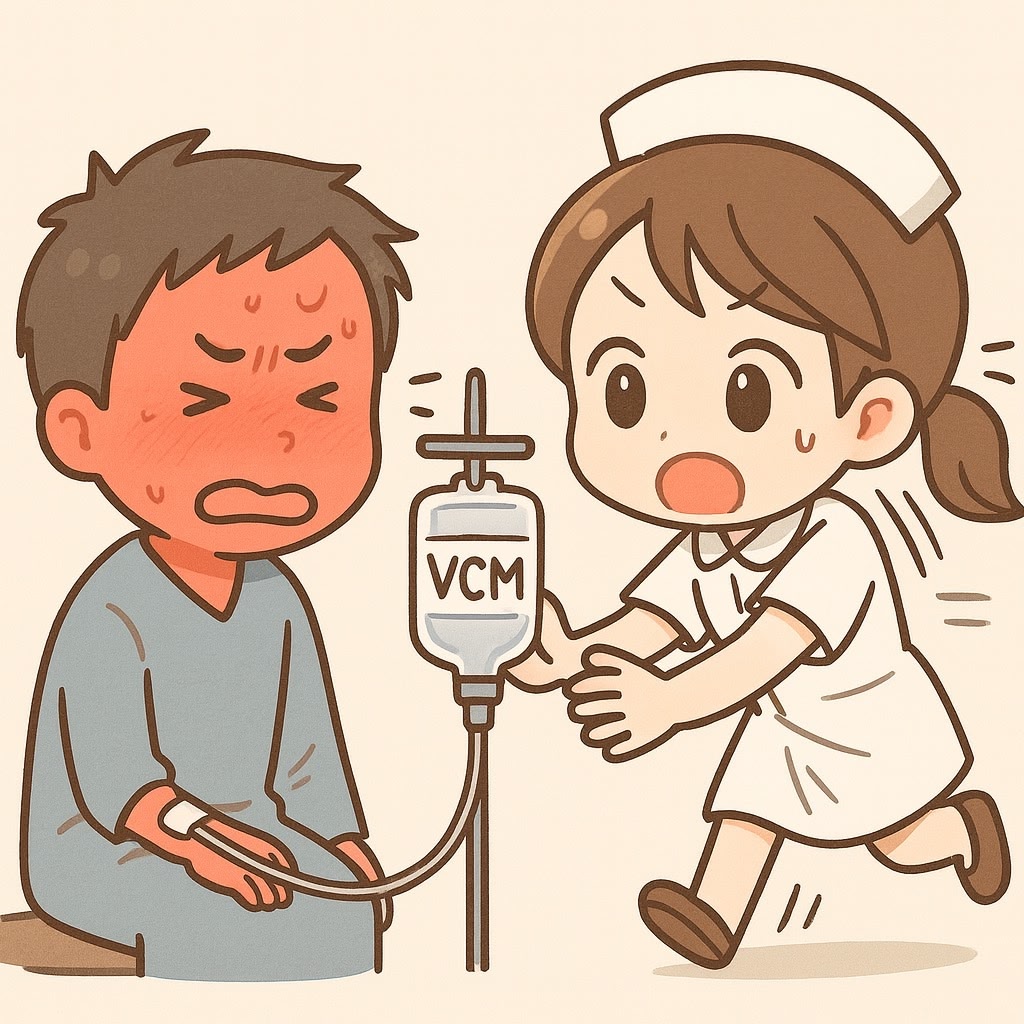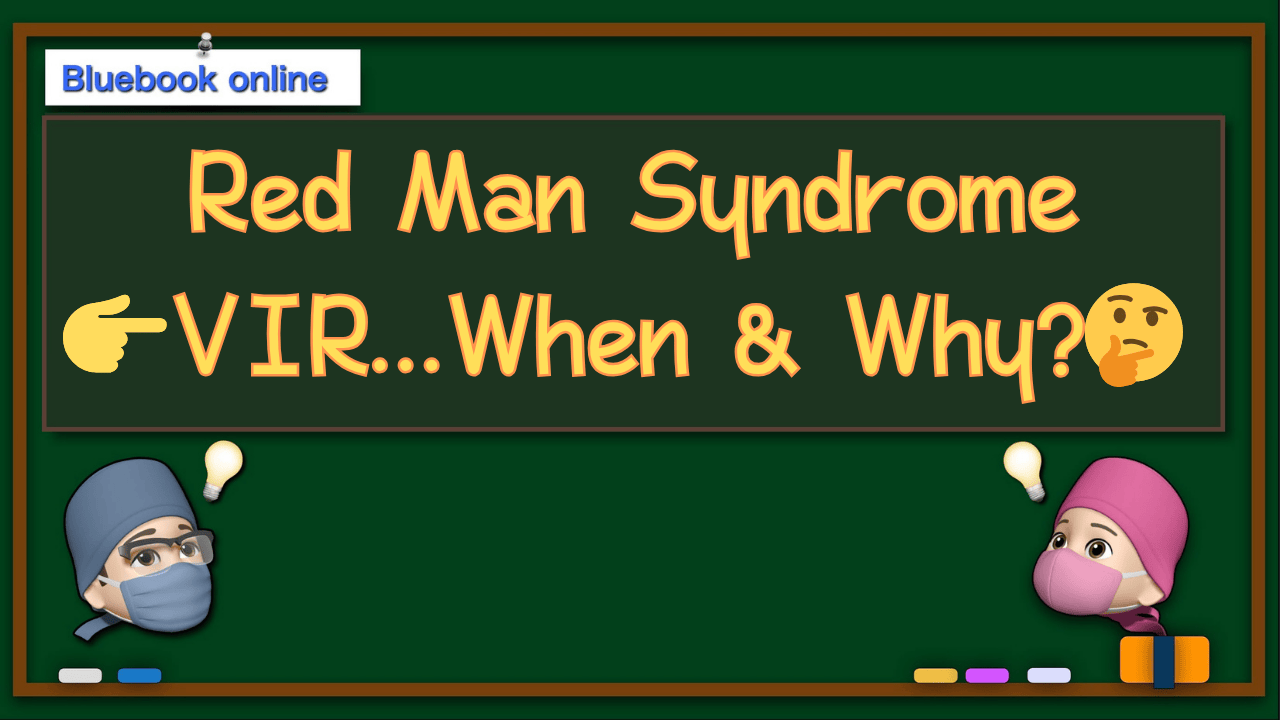👉👉 🇺🇸 All Posts 🇬🇧 / 🇯🇵 記事一覧 🇯🇵 👈👈
♦️ Introduction
 なっちゃん
なっちゃんDoctor, one of our patients turned bright red during vancomycin infusion before surgery… someone said it was ‘Red man syndrome.’
But I heard that term isn’t used anymore—is that true?



Yes. The term ‘Red man (person)’ has been phased out.
Since around 2020, the official terminology is ‘Vancomycin infusion reaction (VIR)’ or sometimes ‘Vancomycin flushing syndrome.’


♦️ Updated terminology and cultural considerations
The term “Red man syndrome” was once used because patients—especially those with light skin—often developed flushing of the face, neck, and upper torso after vancomycin administration.
However, the phrase is now recognized as racially insensitive, as “Red man” overlaps with a historical slur used for Indigenous peoples in North America.
In response, professional societies including the Infectious Diseases Society of America (IDSA), SHEA, and PIDS jointly recommended in 2020 that the reaction be referred to as “Vancomycin infusion reaction (VIR)” instead.
Major journals such as JAMA have also adopted this terminology as part of their inclusive language initiative (2021–2025).
♦️ Mechanism and pathophysiology 🤔
Vancomycin infusion reaction (VIR) is a non–IgE-mediated pseudoallergic reaction—sometimes termed an anaphylactoid reaction.
That means prior sensitization is not required. Vancomycin directly triggers mast cells and basophils to release histamine and other mediators.
The faster the infusion, the higher the risk and severity—hence the common recommendation to infuse each gram over at least 60 minutes (10 mg/min maximum).
- Not IgE mediated → not a true allergy
- Rate-dependent: faster infusions = higher risk
- Infusing 1 g in < 60 min greatly increases incidence
- Tolerance may develop with repeated exposure, but recurrence can still occur
♦️ Anaphylaxis or not? 😳
🔷 Clinical features and differentiation
The typical presentation of VIR is flushing, pruritus, and mild hypotension during or shortly after infusion (usually within 4–10 minutes).
If symptoms progress to respiratory distress, severe hypotension, or multisystem involvement, treat as anaphylaxis until proven otherwise.
| Feature | Vancomycin infusion reaction (VIR) | Anaphylaxis |
|---|---|---|
| Mechanism | Direct histamine release (non–IgE) | IgE-mediated immune response |
| Onset | During or immediately after infusion | Immediately after exposure |
| Skin | Flushing and itching (face, neck, chest) | Urticaria or generalized erythema |
| Airway | Usually absent | Laryngeal edema, bronchospasm |
| Hypotension | Mild (occasionally severe) | Often marked, may cause shock |
| Serum tryptase | Typically normal | Often elevated |
When in doubt, treat as anaphylaxis with epinephrine first, then clarify with history or laboratory findings (e.g., tryptase).
🔷 Prevention and management 😡
Prevention is better than reaction.
The main risk factor is infusion rate. Preventive measures are summarized below:
| Item | Recommendation |
|---|---|
| Infusion rate | ≥ 60 min per gram (max 10 mg/min) |
| Dilution | Use adequate dilution and slow IV rate |
| Premedication | Antihistamines (H₁ + H₂ blockers) for high-risk patients |
| Avoid concomitant histamine releasers | e.g., opioids, some muscle relaxants |
If a reaction occurs
- Stop the infusion immediately
- Assess airway, breathing, circulation
- Mild: give antihistamines
- Severe or unclear: treat as anaphylaxis (epinephrine, fluids, oxygen)
- Once symptoms resolve, vancomycin may be restarted at a slower rate ± antihistamine premedication
♦️Perioperative and anesthetic implications☝️
When vancomycin is infused before anesthesia induction, VIR may mimic intraoperative anaphylaxis, leading to unnecessary alarms or interventions.
🔷 Recommended Timing⏰
- Start 60–120 minutes before induction so infusion is complete before anesthesia begins.
- If possible, infuse while the patient is awake for early recognition of symptoms.
🔷 Practical reminders ✏️
- Flushing + hypotension during infusion → consider VIR
- Avoid co-administration with morphine or histamine-releasing muscle relaxants
- The distinction between VIR and anaphylaxis is a common board-exam topic in anesthesia and perioperative medicine.
🔷 A note on language evolution
While “Red man syndrome” was once medically descriptive, it no longer aligns with inclusive standards.
Medicine—and even engineering—has moved toward neutral terminology. For instance, in device control systems, “master/slave” has been widely replaced by “primary/secondary” or “leader/follower.”
It reflects a broader cultural shift toward scientific precision plus cultural sensitivity.
🌍 Regional Differences
| Category | Japan (🗾) | United States / Europe (🌍) |
|---|---|---|
| Terminology | The term “Red man syndrome” still appears in some Japanese textbooks, package inserts, and older reference materials as of 2025. | The term “Red man syndrome” has been fully replaced by “Vancomycin infusion reaction (VIR)” in medical literature and clinical documentation. |
| Guideline authority & updates | National guidelines (e.g., Japanese Society of Infectious Diseases) and package inserts have been slower to reflect the terminology change. | Since the 2020 IDSA/SHEA/PIDS joint statement, all major U.S. and European guidelines, hospital protocols, and teaching materials now use VIR exclusively. |
| Infusion rate recommendations | Typically “infuse 1 g over ≥60 minutes” is recommended and widely followed in clinical practice. | Similar guidance, but explicitly states “maximum 10 mg/min or ≥60 minutes per gram.” |
| Perioperative timing | Infection-control committees and anesthesia guidelines recommend completing vancomycin infusion 60–120 minutes before induction. | The CDC and AAOS Perioperative Antibiotic Guidelines provide identical timing recommendations (start 60–120 min before incision). |
| Cultural sensitivity and language policy | The discussion on removing potentially discriminatory medical terms is ongoing; “Red man” is sometimes still mentioned as an explanatory historical term. | Since 2020, JAMA, AMA, and other institutions have formally implemented inclusive language policies to eliminate racially or culturally insensitive terminology. |
| Educational context | Medical schools and residency programs are in a transitional phase, teaching both “Red man (old term)” and “VIR (new term).” | U.S. and European institutions prohibit or explicitly discourage using “Red man” in educational or clinical settings. |
📝 Summary: Take Home Points
- “Red man syndrome” → now “Vancomycin infusion reaction (VIR)”
- Mechanism: non-IgE-mediated histamine release
- Prevention: slow infusion + antihistamine premedication
- Perioperatively, differentiate VIR from true anaphylaxis
- Language in medicine continues to evolve toward inclusion and accuracy
📚 References & Further reading
- Martel TJ, Jamil RT, Afzal M. Vancomycin Infusion Reaction. StatPearls. 2025.
- IDSA/SHEA/PIDS Position Statement: Replace “Red Man Syndrome” with “Vancomycin Infusion Reaction.” Hosp Pediatr. 2020;10(7):623–624.
- JAMA Inclusive Language Initiative (2021–2025). JAMA Network
- Renz CL et al. Oral antihistamines reduce the side effects from rapid vancomycin infusion. Anesth Analg. 1998;87(6):1340–5.
- CDC/AAOS. Perioperative Antibiotic Guidelines. 2025.
- Cureus 2024. Vancomycin Flushing Syndrome: A Case Report.
- Medsafe, 2023. Infusion-related reactions: not all allergy-related.
🔗 Related articles
- to be added

コメントを投稿するにはログインしてください。